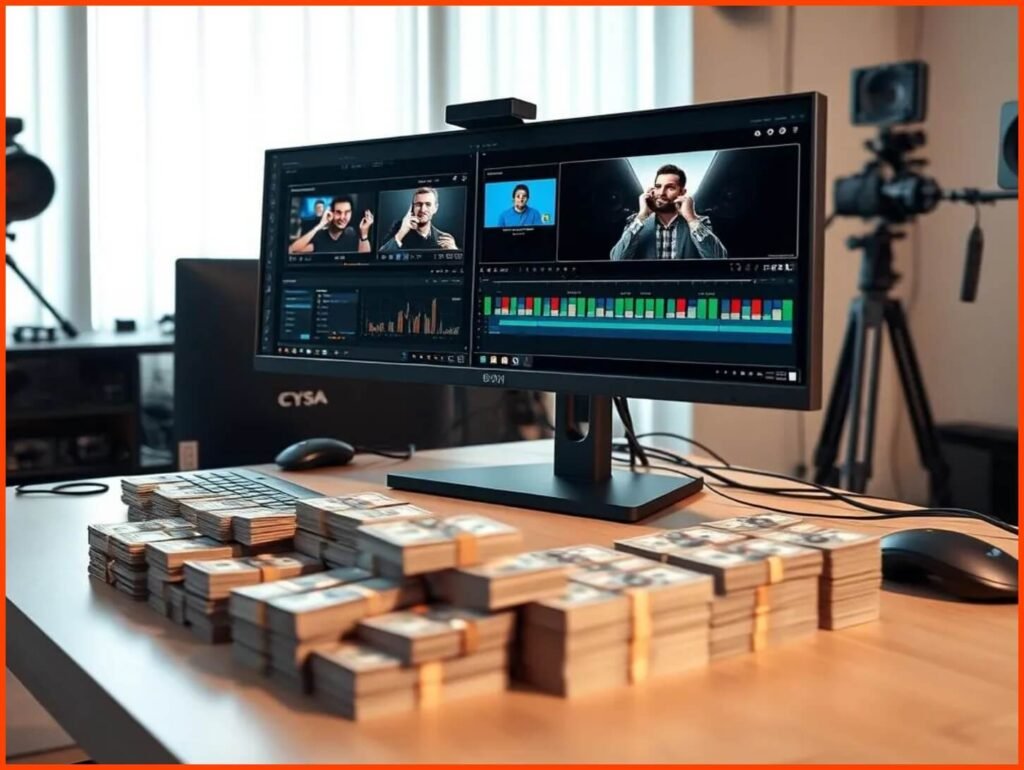If you’re here, it’s probably because you’re interested in making money with video editing. Maybe you’ve been editing videos for fun, or you’re just starting to learn and want to make money from it. I get it, starting something new can be tough, but don’t worry, I’m here to make it easy for you. In this guide, I’ll share easy and practical tips to help you make money with video editing. These are things that have worked for me and others. Let’s get started and begin your journey to success with video editing!
Why Video Editing Is a High-Demand Skill
You’ve probably noticed that a lot of people on social media are making money through video editing. Whether it’s YouTubers, influencers, or businesses—everyone needs video content, and they need it edited. This is your opportunity. More people are creating videos now than ever, so the need for video editors is growing fast. The best part is, you can be a part of this growing trend.
Start Learning Video Editing
If you already know the basics of video editing, that’s great! But if you’re just starting and don’t know much yet, don’t worry. You can still make it work. If you don’t have a laptop or computer, it’s totally fine, You can start with your mobile using apps like CapCut or Alight Motion. I started the same way! Once you make some money, you can switch to a laptop or PC, because clients usually prefer editing on those. But don’t get discouraged—just start and keep learning, no matter what device you have!
Create Your Portfolio
A portfolio is a collection of your best work that shows what you can do. It’s important because it helps potential clients see your skills and style. Without a portfolio, it’s hard to prove what you can do.
To create your portfolio, pick a few of your best videos that show your editing skills. If you’re just starting and don’t have paid projects yet, You can edit raw clips from podcasts or YouTube videos to practice. Once you have a few good examples, put them all in one place, but don’t use Google Drive as your portfolio. Trust me, it’s one of my worst mistakes! Clients see it as unprofessional and it doesn’t work well. Instead, use platforms like Behance, Wix, or Adobe Portfolio to create a free, professional-looking portfolio. These platforms make it easy to showcase your work and look more professional to potential clients.
Create Your Socials
Create social media accounts like Instagram, TikTok, Facebook, twitter or YouTube to share your video editing work. Post clips of videos you’ve edited or before-and-after edits. This helps people see your skills and gives clients a place to find you. Also, share client testimonials if you can. Positive reviews from people you’ve worked with will make you look more trustworthy to new clients. Keep posting regularly, and soon more people will notice your work!
By showing your work online, you might even catch the attention of agencies. Once they see your skills, they might hire you and give you more work on a regular basis. I’ve worked for 2-3 agencies myself, and it’s a great way to keep getting new projects
Set Your Rates
Now that you have your portfolio and social media set up, it’s time to figure out how much to charge. At first, it might feel tricky, but just remember, you can change your rates later as you get better. Start by charging what feels fair for your current skills. As you get more experience, you can raise your rates. Remember, you don’t have to charge too little just to get work. Even when you’re starting out, it’s important to value your time and skills.
In the beginning, I struggled with setting my rates. I was afraid of asking for too much, so I started charging very little. I quickly realized that my time and effort were worth more than I was charging, so I raised my rates as I gained experience. It wasn’t easy, but as I gained confidence, I began to charge what I felt was fair for the value I was providing.
Reach Out to Clients
After creating your portfolio, it’s time to start finding clients. A good place to start is by reaching out to social media influencers or small businesses that might need video editing help. You can tell them how your editing services can help them get more likes, views, and attention on their videos. Let them know that with better editing, their videos will look more professional, which can help them get more followers or customers. Explain that great editing can help them stand out and get more engagement.
When you message them, keep it simple and friendly. Introduce yourself, share your portfolio, and explain how you can help them. If they like what you offer, you can talk about the details and make a deal. Starting with a few clients can help you build your reputation and get more work later!
Ways to Earn Money with Video Editing
1. Freelance Projects: You can find video editing jobs on websites like Upwork, Fiverr, or Freelancer. These sites help connect you with people who need videos edited. You can choose projects that fit your skills.
2. Work with YouTubers: Lots of YouTubers need help with editing their videos. You can contact them directly through social media and offer to make their videos look better and save them time.
3. Create Your Own YouTube Channel: You can start your own YouTube channel. Your editing skills can help you create professional-looking videos that attract viewers. As your channel grows, you can earn money through ads, sponsorships, or even selling your own products. Plus, you’ll build a loyal audience who loves your content.
4. Edit for Businesses: Small companies and big brands often need videos for their websites or social media. You can edit videos like ads or product videos to help them look professional.
5. Create Online Courses or Tutorials: If you’re really good at video editing, you can teach others how to do it. Platforms like Udemy or Skillshare let you make and sell video courses or tutorials.
6. Social Media Content Creation: Many businesses need videos for platforms like Instagram, TikTok, or Facebook. You can create and edit fun and engaging videos for them.
7. Work for Agencies: Some agencies hire video editors to work on many projects. If you impress them, they may give you a lot of work regularly.
8: Affiliate Marketing: You can also use your video editing skills to promote products through affiliate marketing. By creating product review videos, tutorials, or “how-to” videos, you can include affiliate links in the video descriptions. When viewers purchase through those links, you earn a commission. Many companies offer affiliate programs, and this can be a great way to earn passive income while doing what you love.
Keep Improving Your Skills
Now that you know how to make money with video editing, it’s important to stay motivated and keep improving. Don’t worry if things seem tough at times – challenges are part of the process. To keep improving, practice regularly, even if it’s just for a few minutes a day. The more you practice, the better you’ll get. Keep learning too, as video editing tools and trends are always changing. Watch tutorials, read blogs, or take courses to stay updated. The more you learn, the better your editing will become, and that will help you attract more clients and grow your skills.
Final Thoughts
Making money with video editing is not as hard as it seems. All it takes is starting small, learning as you go, and staying consistent. I know from experience that the journey can feel overwhelming at first, but trust me, every step you take will bring you closer to success. There will be times when you’ll have to edit videos for a low price, but don’t let that discourage you. That’s just part of the journey. Eventually, there will also be moments when you’ll land projects that require simple edits but pay really well. The key is to stay motivated and keep improving your skills.
Remember, you don’t have to be perfect when you start, it’s all about learning and getting better over time. Keep practicing, improve your communication skills, meet the right people, and trust that your skills can make a difference. If I can do it, you can too!
You’ve Got Questions, I’ve Got Answers
Q1: Do I need expensive equipment to start video editing?
No, you can start with a basic computer or even a smartphone. As you earn money, you can invest in better equipment.
Q2: How do I find my first clients?
Create a good portfolio and reach out to YouTubers, influencers, or small businesses. Use freelancing platforms like Upwork or Fiverr to connect with clients.
Q3: What is the salary of a beginner video editor?
A beginner video editor can earn anywhere from $10 to $20 per hour, or around $200 to $300 per project, Depending on the project and client, your pay may vary. As you gain more experience, you can earn much more.
Q4: Do I need to take a course to learn video editing?
Not necessarily. There are plenty of free tutorials on YouTube and other platforms where you can learn the basics and improve your skills.
Q5: How do I decide what to charge for my work?
Start with rates that match your skill level. As you gain experience and improve, increase your rates. Research what others in your skill range are charging.





